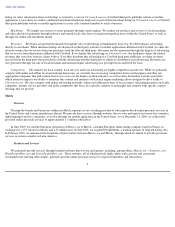ServiceMagic 2009 Annual Report Download - page 18
Download and view the complete annual report
Please find page 18 of the 2009 ServiceMagic annual report below. You can navigate through the pages in the report by either clicking on the pages listed below, or by using the keyword search tool below to find specific information within the annual report.
Table of Contents
manner to frequent changes in user and customer requirements, which can be difficult to predict, or appropriately time the introduction of
enhancements and/or new products or services to the market. Our inability to provide quality products and services would adversely affect user
and customer experiences, which would result in a decrease in traffic to our various websites, lower conversion rates and a related decrease in
revenues, which would adversely affect our business, financial condition and results of operations.
As discussed below, these traffic building and conversion initiatives also involve the expenditure of considerable sums for marketing, as
well as for the development and introduction of new services, products and enhancements, infrastructure and other related efforts.
Marketing efforts designed to drive traffic to our various websites may not be successful or cost
-effective.
Traffic building and conversion initiatives involve considerable expenditures for online and offline advertising and marketing. We have
made, and expect to continue to make, significant expenditures for search engine marketing (primarily in the form of the purchase of keywords),
online display advertising and traditional offline advertising in connection with these initiatives, which may not be successful or cost-effective.
In the case of our search engine marketing efforts, our failure to respond successfully to rapid and frequent changes in the pricing and operating
dynamics of search engines could adversely affect the placement of paid listings that appear in response to keywords we purchase, as well as
adversely affect the pricing of the online advertising we purchase generally, which would increase our costs.
One of the most cost-
effective efforts we employ to attract and acquire new, and retain existing, users and members is commonly referred to
as search engine optimization, or SEO. SEO involves developing websites to rank well in search engine results. Search engines frequently update
and change the logic that determines the placement and display of results of user searches. The failure to successfully manage SEO efforts across
our businesses, including the timely modification of SEO efforts from time to time in response to periodic changes in search engine algorithms,
search query trends and related actions by providers of search services designed to ensure the display of unique offerings in search results (which
actions by search service providers may result in algorithmic listings being displayed less prominently within search engine results), could result
in a substantial decrease in traffic to our various websites, which would result in substantial decreases in conversion rates and repeat business, as
well as increased costs if we were to replace free traffic with paid traffic, any or all of which would adversely affect our business, financial
condition and results of operations.
Lastly, as discussed above, we also enter into various arrangements with third parties in an effort to increase traffic, which arrangements are
generally more cost-effective than traditional marketing efforts. If we are unable to renew existing (and enter into new) arrangements of this
nature, sales and marketing costs as a percentage of revenue would increase over the long-term.
Any such failure to attract and acquire new, and retain existing, traffic, users and customers in a cost-effective manner could adversely
affect our business, financial condition and results of operations.
We may not be able to adapt quickly enough to changing industry standards.
The e-commerce industry is characterized by evolving industry standards, coupled with frequent and related new service and product
introductions and enhancements. The development of new service and product introductions and enhancements in response to evolving industry
standards requires significant time and resources and we may not be able to adapt quickly enough (and/or in a cost-effective manner) to these
changes or appropriately time the introduction of new services and products to the market and our failure to do so could adversely affect our
business, financial condition and results of operations.
14
























